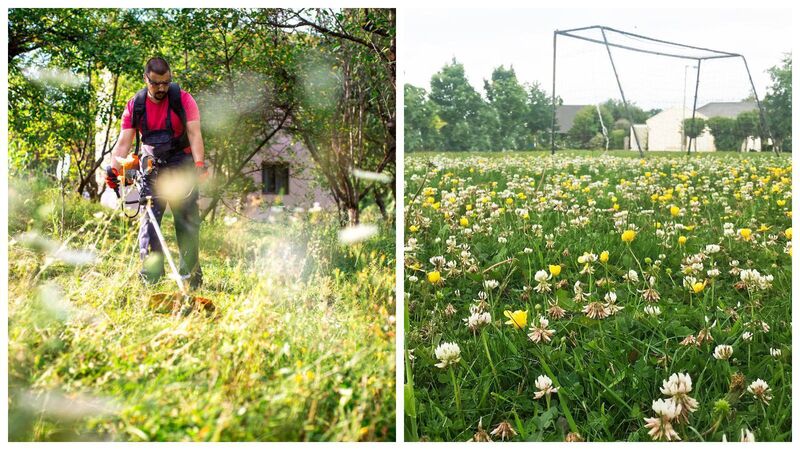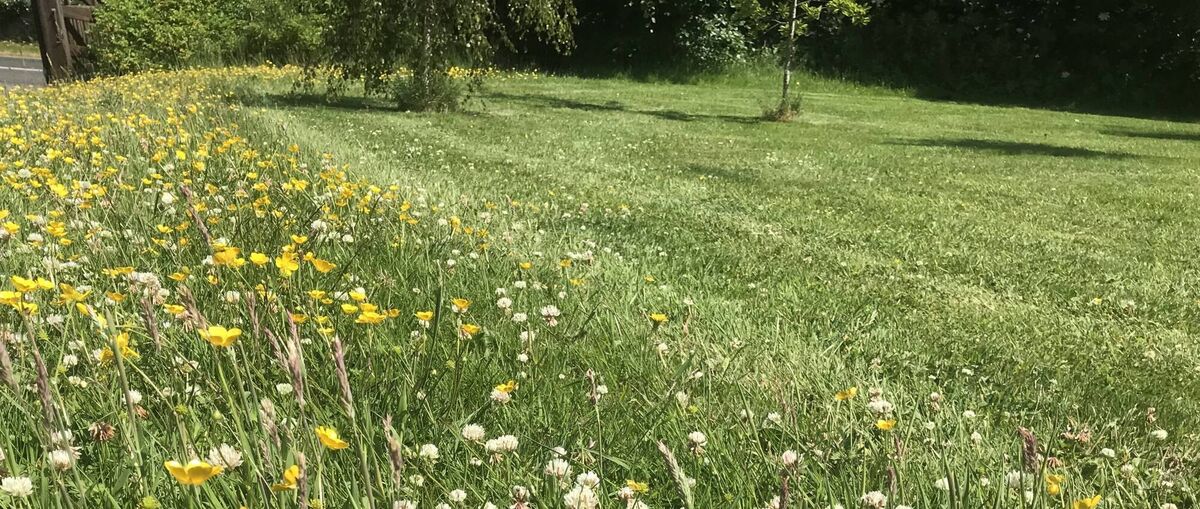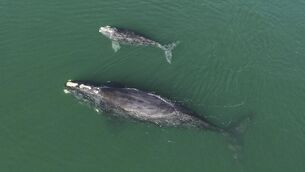This Father’s Day, why not relax and leave the lawnmower in the shed?

Reducing your grass-cutting doesn’t have to mean you’re letting your garden go ‘wild’. Instead, you might want to simply change from a weekly cut to every three, four or even six weeks. Right: An old name for clover is ‘bee’s bread’, it is so loved by bees. A clover lawn also has a short sward so it can still be used for football! Picture: Juanita Browne
Finally, the sun is shining. At long last, you get to sit outside on that expensive garden furniture you bought during lockdown, but rarely get to use in our Irish climate. You get everything ready, the cushions, the sunglasses, the bottle of sunscreen. You settle down with a favourite book and maybe even a glass of wine. You can hear birds singing and the bees buzzing. The quiet hum of nature makes you feel even more relaxed… and then it begins.
The silence is broken by a loud revving and engine splutter. A lawnmower engine roars into action in the garden next door. Soon, a strimmer cranks up down the road. A chainsaw joins the soundscape somewhere. The house-proud Dads are out while the sun shines. You try to wait it out, but it’s difficult to read, and you can no longer hear the birds singing. The spell is broken, you retreat back indoors and close the windows to muffle all the noise. Sadly, it’s the same story every weekend!
Of course, it’s understandable — that those of us with a fetish for a neat garden are also waiting for a window of good weather and have to make the most of it. But it’s not just the noise that’s the problem. Perhaps we should have a little rethink about all this ‘tidying up’ we do in our gardens. When we cut our grass, we also prevent wildflowers from growing. Those wildflowers would feed the bees, hoverflies and butterflies, which pollinate our crops and themselves become food for our birds. Already squeezed out of much of the countryside due to intensive farming, pollinators often seek refuge in wildlife-friendly gardens, but only if there is food to invite them in.
In a climate crisis, burning petrol to cut our lawn probably isn’t the best use of a fossil fuel either. And while it’s easy to think ‘but it’s just my small lawn’, it is estimated there are at least two million domestic lawns in Ireland – that’s a vast area of land. Research in the United States found that lawns covered an estimated 63,000 square miles in 2005. That's about the size of Texas, making lawn grass the most common crop in the US — just one that humans can’t eat. The pesticides, herbicides and fertilisers we add to our lawns also cause pollution to our rivers and streams.
But we do love our lawns and it seems the shorter the grass, the better. A farmer friend who is passionate about nature, once told me: “one of the most dangerous things for nature in Ireland is a middle-aged man who gets himself a ride-on lawnmower”.

Reducing your grass-cutting doesn’t have to mean you’re letting your garden go ‘wild’. Instead, you might want to simply change from a weekly cut to every three, four or even six weeks. This will allow low-flowering plants, such as red and white clover, to flower and provide food for pollinators, and your garden can still look managed. Cutting a one-metre strip around the edge of your wildflower patch to create sharp borders can also help to show your neighbours that this is a planned project and you haven’t simply become lazy about your garden. Cutting curved paths through the centre of your meadow can also be a lovely way for children to enjoy the area and get up close to the butterflies and bugs that will make it their home.
Lots of people took part in #NoMowMay, but it’s also good to continue to allow wildflowers to grow right through to September. If you do want to develop a wildflower strip/patch, it’s really important to always remove your lawn cuttings. Mulching cuttings back into your lawn will increase the fertility of the soil meaning the stronger grasses, nettles or thistles will do better. Wildflowers do best in less fertile soils, so you’ll get more variety and abundance of wildflowers if you always remove the clippings.
In my own lawn, reduced mowing quickly resulted in lots of beautiful wildflowers, including germanders, stitchwort, clovers, selfheal, bird’s-foot-trefoil, vetches, cuckooflower, daisies, and even the beautiful common-spotted orchid. It’s amazing to think all of these seeds have been lying in wait for an opportunity to bloom all these years. It’s a joy to watch all the insects benefit from these pollen-rich wildflowers and of course, more insects attract more birds, making the whole garden a much more interesting space. Our native wildflowers may be small, but they form the base of the food chain for so much biodiversity, so reducing grass-cutting is such an easy way to help.
So this Father’s Day, why not put away the keys to the mower, relax, and simply enjoy watching nature do its thing.
- For lots of tips and videos to guide you in converting your lawn to wildflower meadow, see pollinators.ie
- Juanita Browne has written a number of wildlife books, including My First Book of Irish Animals and The Great Big Book of Irish Wildlife







